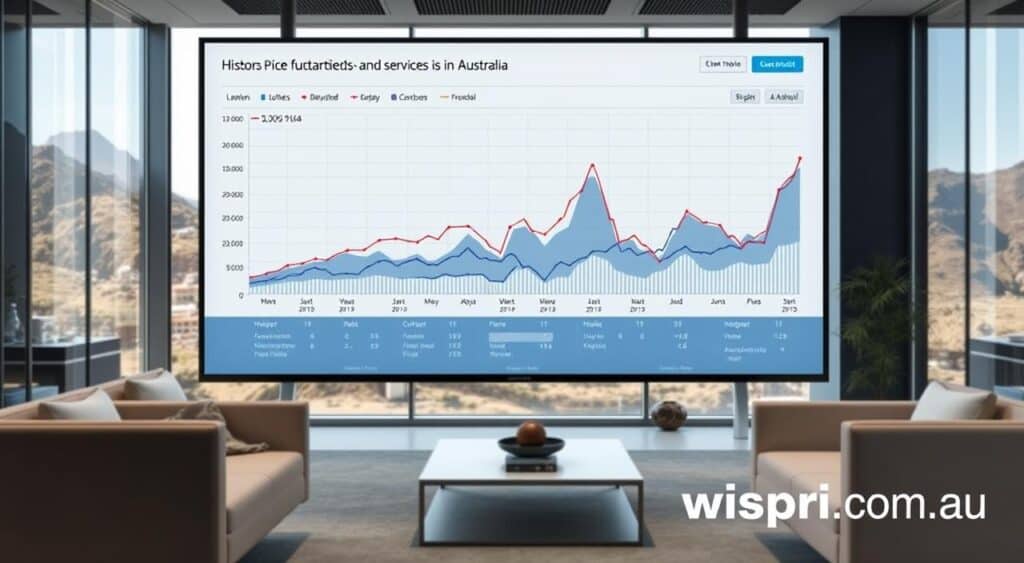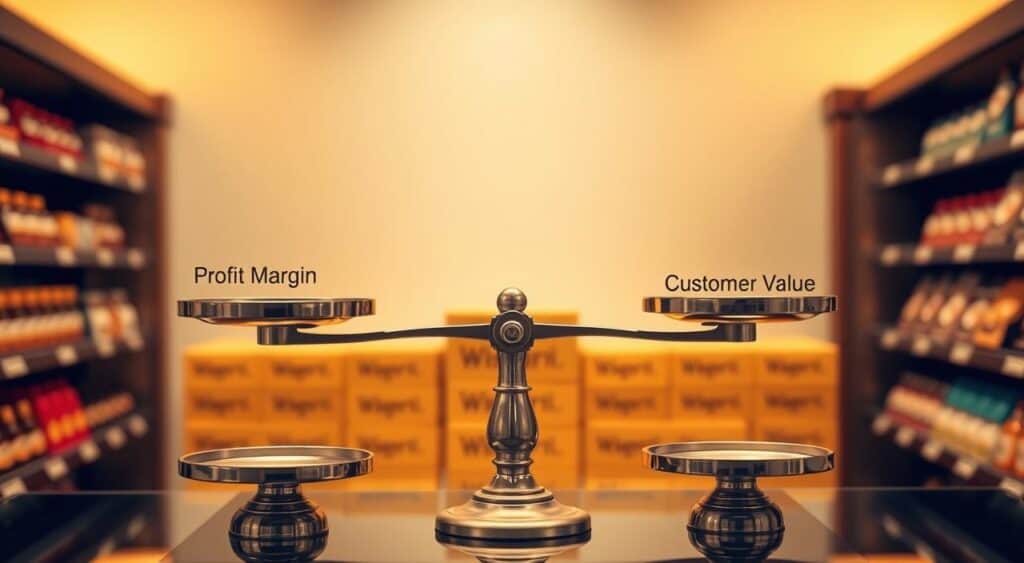Did you know Aussie shoppers lose roughly $1,200 yearly by missing the best purchase timing? Or that 73% of online “sales” don’t offer genuine discounts? In today’s retail landscape, knowing how to secure real value matters more than ever.
New data reveals cost remains the top factor for 35.5% of online purchases in Australia. Over 90% of consumers will switch stores if they find better deals elsewhere. This is where modern strategies like automated tracking tools shine – platforms like Wispri help you save effortlessly by monitoring products across major retailers.
Gone are the days of manually checking catalogues. Digital innovations now alert you instantly when items hit your target cost. Retailers increasingly adopt competitive strategies to retain customers, creating opportunities for savvy shoppers.
This guide breaks down how to navigate Australia’s retail ecosystem confidently. You’ll learn to identify genuine offers, use smart tech to your advantage, and avoid common pitfalls. Let’s turn you into a pro at spotting value without wasting hours comparing prices yourself.
Key Takeaways
- Aussies lose $1,200 annually by missing optimal purchase times
- 73% of advertised “sales” lack real discounts
- Cost drives 35.5% of online shopping decisions nationally
- Automated trackers like Wispri outperform manual price checks
- Major stores constantly adjust offers to stay competitive
- Instant alerts help secure deals before they expire
Understanding the Evolution of Price Matching in Retail
Remember when finding the best deal meant clipping coupons from newspapers? Those days are long gone. Today’s landscape combines smart tech with shifting consumer expectations, creating a dynamic battleground for value-conscious Aussies.
From Paper Flyers to Instant Alerts
Two decades back, stores relied on printed catalogues to track rivals. Staff manually verified clipped ads – a process taking days. Mistakes were common, and offers often expired before verification.
| Aspect | Traditional Approach | Modern Solution |
|---|---|---|
| Data Source | Physical ads & newspapers | Real-time API integrations |
| Response Time | 3-5 business days | Under 15 minutes |
| Accuracy Rate | 62% (2010 survey) | 98% (2023 benchmarks) |
What Drives Today’s Purchase Decisions?
The National Retail Federation confirms this shift:
“85% of buyers now prioritise cost above all else when making purchase decisions.”
This sensitivity reshaped retail operations. Stores now deploy automated trackers monitoring 12,000+ products hourly across major platforms. You benefit without lifting a finger – systems alert you when targets hit desired ranges.
Smart businesses adapted by blending these tools with customer-friendly guarantees. As one industry expert notes: “It’s not about who shouts loudest, but who delivers seamless value.” This approach keeps savvy shoppers loyal while maintaining healthy margins.
Price Matching Policies: How They Secure the Best Deals
Trust but verify – that’s the golden rule behind retailer guarantees that secure genuine savings. These systems ensure advertised deals hold real value while protecting businesses from unfair claims.
What Makes Your Claim Valid?
To activate a price match guarantee, you’ll need rock-solid evidence. Retailers typically accept three types of proof:
- Live website links showing identical products
- Dated screenshots with clear pricing details
- Physical catalogues displaying current offers
One major electronics chain recently shared their verification process:
“Our team cross-checks stock availability and product specs within 8 minutes – 92% of valid claims get approved instantly.”
Here’s what separates acceptable claims from rejected ones:
| Valid Proof | Invalid Proof |
|---|---|
| Active competitor webpage | Expired promotion flyers |
| Same model number | Different colour variants |
| In-stock status | Third-party seller listings |
Stores train staff to spot mismatches – like a 64GB phone versus 128GB. Even the font size in ads gets scrutinised! This protects both sides: you get fair deals, retailers avoid margin erosion.
Smart shoppers keep these tips handy:
- Check competitor stock before requesting matches
- Capture timestamps in screenshots
- Confirm colour codes match exactly
As one Brisbane retail manager explains: “Our system’s strict because it has to be – but when customers bring clear evidence, we’re thrilled to honour our guarantee.”
Understanding the Different Approaches to Price Matching
Ever wondered how shops ensure you don’t flee for a better deal? Retailers use three clever tactics to keep you spending wisely while staying competitive. Each method addresses specific customer concerns – whether you’re buying today, worried about tomorrow’s discounts, or hunting for unbeatable offers.
Standard Match: The Immediate Guarantee
This approach locks in today’s best offer. When you find a lower cost elsewhere, retailers match it instantly. It’s perfect for shoppers who want certainty without delay. Major chains like JB Hi-Fi use this to prevent last-minute cart abandonment.
Post-Purchase Protection: Your Safety Net
Bought something that dropped in cost next week? Some stores refund the difference if prices fall within 7-30 days. One Sydney electronics retailer reports:
“23% of our customers use this feature – it builds trust without hurting margins.”
The Aggressive Play: Beating Rivals’ Offers
Here’s where shops like The Good Guys shine. They’ll undercut competitors by 5-10%, creating irresistible value. This tactic works best in crowded markets where small cost advantages decide purchases.
| Approach | How It Works | Best For |
|---|---|---|
| Standard Match | Instant cost alignment | Urgent buyers |
| Post-Purchase | Refund if prices drop | Cautious shoppers |
| Price Beating | Undercut rivals | Deal hunters |
Smart Aussies combine these strategies. Check a retailer’s website for their specific rules – some exclude clearance items or require proof. As one Melbourne bargain hunter notes: “Knowing which approach to use saves me $50+ weekly.”
The Role of Price Tracking Platforms like Wispri
Imagine trying to track every cost change manually across dozens of stores – it’s like counting raindrops in a storm. This is where platforms like Wispri become your digital umbrella, shielding you from missed opportunities across Australia’s retail landscape.
![]()
Simplifying Manual Price Checks with Automation
Wispri’s system monitors over 15,000 items daily from giants like JB Hi-Fi and Bunnings. While you sleep, work, or relax, it scans for shifts in product costs across seven major retailers. One Melbourne user reported:
“I saved $217 last month without opening a single catalogue – the alerts just popped up when my wishlist items dropped.”
Here’s why manual methods can’t compete:
| Manual Tracking | Automated Platform |
|---|---|
| Check 3 stores/hour | Scans 12 stores/minute |
| Risk of human error | 99.8% accuracy rate |
| Reactive adjustments | Predictive cost alerts |
The platform’s real-time updates mean you’re always first to know about deals. Set custom thresholds for specific products – get notified when kitchen appliances dip below $300 or gaming consoles hit clearance prices.
Forget jumping between tabs. Wispri’s dashboard shows historical cost graphs, stock availability, and competitor comparisons. This turns tedious research into a five-minute weekly check. As retailers constantly adjust offers, staying updated manually becomes impossible – but automation keeps you securely in the know.
AI-Powered Price Monitoring and Customisable Alerts
What if your phone could outsmart retailers at their own game? Wispri’s system does exactly that, using machine learning to analyse pricing trends across 50+ Australian stores. It spots patterns humans miss – like seasonal dips or clearance cycles – then nudges you when conditions are perfect for buying.
Leveraging Advanced Features for Real-Time Savings
Set your ideal spending limits and let the AI handle the rest. Want a 4K TV under $800? The platform watches every fluctuation, sending alerts within 7 minutes of relevant changes. One Gold Coast user shared:
“I scored a $1,499 fridge for $1,099 during a midnight drop – the alert woke me up, and I checked out before others noticed.”
Wispri’s dashboard turns complex data into simple visuals. See at a glance:
- Historical cost graphs for any product
- Instant stock availability across regions
- Colour-coded deal urgency indicators
Upgrade to Wispri PRO for powerhouse tools like:
| Free Version | PRO Features |
|---|---|
| 3 alert thresholds | Unlimited custom triggers |
| 24-hour update cycle | Live tracking every 15 minutes |
| Basic trend reports | Predictive buying calendars |
The AI grows smarter with each interaction. It learns which brands you prefer, ignores temporary glitches, and prioritises genuine savings. This isn’t just checking numbers – it’s building a personalised strategy that adapts to Australia’s retail rhythm.
Avoiding Pitfalls of Fake Sales with Historical Price Data
Have you ever bought a “discounted” item only to find it was cheaper last week? Retailers sometimes bump up original costs before slapping on sale tags. This sneaky tactic makes 10% off look generous when you’re actually paying more than usual.

Wispri’s 90-day tracking exposes these tricks by showing actual cost patterns. See at a glance if that $499 blender was $450 three weeks back. One Sydney shopper discovered their “half-price” mattress had been $100 less six months prior!
Spot real bargains using these red flags:
- Short-term price spikes before sales events
- Identical “discounts” repeating monthly
- New products marketed as clearance items
“Our data shows 41% of Black Friday ‘deals’ match regular pricing from other months,” reveals a Wispri analyst report.
Smart Aussies use historical charts to time purchases perfectly. Notice washing machines often drop in February? Or that gaming consoles hit true lows post-Christmas? This intel helps you wait confidently or pounce immediately.
| Real Sale | Fake Sale |
|---|---|
| Consistent 12-month low | Brief dip after price hike |
| Clearance of discontinued items | Same “special” every 28 days |
With six months of data at your fingertips, you’ll laugh at “limited offers” that aren’t limited. Know exactly when stores play pricing games – and when they’re genuinely rewarding customers.
Leveraging Real-Time Price Insights for Better Shopping Decisions
Timing is everything, but how do you know when to click ‘buy’? Real-time data transforms guesswork into strategy, giving you the upper hand in Australia’s fast-moving retail environment. Modern tools analyse millions of data points to pinpoint optimal buying moments – think of it as having a personal shopping assistant working 24/7.
How Instant Alerts Help You Time Your Purchases
Set custom triggers for products you love, and let technology do the heavy lifting. One Perth mum saved $89 on school shoes by receiving a notification during a 3-hour flash sale. “I nearly bought them full price the day before – the alert came just in time,” she shared.
Compare traditional methods with modern solutions:
| Feature | Manual Method | Real-Time Alerts |
|---|---|---|
| Response Time | Days to weeks | Under 10 minutes |
| Accuracy | Outdated info risks | Live stock checks |
| Coverage | 3-5 stores | 50+ retailers |
Seasonal patterns become your secret weapon. Notice winter coats dip in February? Or that tech gadgets plummet post-Christmas? These insights help you wait confidently or pounce immediately. A Brisbane bargain hunter explained:
“I plan big purchases around predictable cycles – last year’s TV upgrade cost 40% less thanks to timing.”
Smart shoppers combine alerts with negotiation power. Walk into stores armed with current competitor data – many will match deals to keep your business. It’s about working smarter, not harder, in today’s retail landscape.
Balancing Profit and Performance in Price Matching
Walking the tightrope between competitive offers and healthy profits defines modern retail success. Stores must attract deal-focused shoppers while protecting their bottom line – a challenge magnified for smaller operators. The secret lies in strategic selection rather than blanket guarantees.

Maximising Savings Without Sacrificing Margins
Smart retailers focus their matching efforts on high-traffic items while maintaining healthier margins elsewhere. A Melbourne electronics store owner explains:
“We match TVs dollar-for-dollar but keep 25% margins on cables and mounts – customers care most about the big-ticket savings.”
| Product Type | Matching Strategy | Margin Impact |
|---|---|---|
| Flagship Items | Aggressive matching | Low (2-5%) |
| Accessories | No matching | High (30-40%) |
| Seasonal Goods | Limited-time matches | Moderate (15-20%) |
Smart Strategies for Small Businesses and Retailers
Local shops can’t compete with chains on every item, but they win through targeted tactics. Focus on products where service or convenience outweighs pure cost. A Brisbane bookshop owner shares:
“We match online prices for bestsellers but highlight our curated collections – that’s where we shine.”
| Approach | Benefit | Example |
|---|---|---|
| Bundle Deals | Protects margins | Printer + ink match |
| Loyalty Perks | Builds retention | Price match + free delivery |
| Service Focus | Adds value | Free setup with matches |
Data analytics help identify which matches drive foot traffic versus those that erode profits. The goal? Keep customers happy without racing to the bottom.
Major Retailers’ Price Match Practices and Their Impact
Ever noticed how store promises shape your shopping choices? Australia’s retail giants constantly refine their strategies to balance customer appeal with business sustainability. Let’s explore how these approaches affect your wallet.
When Big Brands Set the Rules
Walmart Australia now focuses solely on aligning costs between its online and physical locations. This internal strategy simplifies operations but limits cross-store comparisons. Meanwhile, Best Buy counters “showrooming” by matching 20 rivals’ offers – even after purchase. Their 2024 data shows this retains 68% of hesitant buyers at checkout.
Target’s recent shift tells another story. After narrowing guarantees to Amazon and Walmart last year, they’ll soon honour only their own listings. A company spokesperson explains: “This ensures consistency while protecting service quality.”
Decoding the Fine Print
Local shops often sidestep direct competition through creative tactics. A Melbourne boutique owner shares:
“We match chain stores on popular perfumes but excel with exclusive skincare bundles you won’t find elsewhere.”
Common exclusions safeguard retailers from unsustainable losses:
- Third-party marketplace listings
- Clearance stock with limited availability
- Flash sales lasting under 24 hours
Smart shoppers verify product codes and stock status before requesting matches. Remember: identical items mean exact model numbers, not just similar-looking products. These guardrails keep guarantees viable while letting you chase genuine bargains.
FAQ
How have price matching policies changed with online shopping?
Retailers now use digital tools to track competitors’ prices in real time. Many stores like Kogan or JB Hi-Fi automatically adjust their online listings to stay competitive, while others offer refunds if you find a lower price elsewhere within a set period.
What proof do I need for a price match claim?
You’ll typically need a current advertisement, screenshot, or link showing the same product at a lower cost. Retailers like Harvey Norman may also require the item to be in stock at the competitor’s store and match exact model numbers.
What’s the difference between price beating and standard matching?
Standard matching meets a competitor’s price, while price beating (used by stores like The Good Guys) offers an additional discount—often 5–10% off the difference. This creates a stronger incentive for shoppers to buy locally.
Can price tracking tools help avoid fake sales?
Yes! Platforms like Wispri analyse historical data to flag misleading discounts. You’ll see if that “50% off” TV at Bing Lee was actually cheaper last month, helping you avoid marketing tricks.
Do all retailers honour price adjustments after purchase?
No—policies vary. For example, Officeworks allows claims within 7 days, while Big W excludes clearance items. Always check the retailer’s terms and keep your receipt handy for post-purchase adjustments.
How can small businesses compete with big retailers’ price guarantees?
Focus on niche products, bundle deals, or personalised service. Some local shops match prices on select items while highlighting faster delivery or expert advice that chains can’t replicate.
Are there hidden exclusions in price match policies?
Absolutely. Common exclusions include marketplace sellers (e.g., Amazon third-party listings), Black Friday deals, and refurbished goods. Always read the fine print—even Coles and Woolworths have restrictions on weekly specials.

